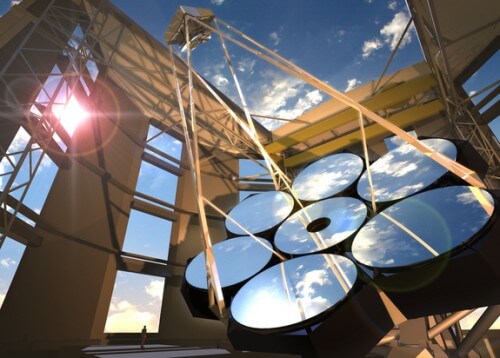The telescope was built and will be maintained by 11 institutions in Australia, Brazil, Chile, Korea and the USA, and they have already allocated about 500 million dollars for the start of construction

An artist's rendering of the Giant Magellan Telescope (GMT) to be built on the summit of Las Campanes in Chile. The telescope will include seven mirrors arranged together to create a light-receiving surface 24 meters wide. Photo Giant Magellan Telescope – GMTO Corporation
This week, work will begin on the construction of a huge telescope at the Las Campanes Observatory in the Chilean Andes. Today, 11/11/5 there will be a ceremony to mark the event. The telescope, known as the Giant Magellan Telescope (GMT), will be used to search for signs of life in the atmospheres of planets outside the solar system, investigate the nature of dark matter and dark energy and try to answer big cosmic questions. The telescope was built and will be maintained by 11 institutions in Australia, Brazil, Chile, Korea and the USA, and they have already allocated about 500 million dollars to start construction.
.
When its construction is finished, the telescope will contain seven mirrors with a diameter of 8.4 meters each, arranged in such a way that they will be used as one device for collecting light in an area of 24 meters in diameter, as well as seven smaller mirrors that will change their shape to compensate for the blurring effects of the Earth's atmosphere. In this way, the new observatory will have a resolution 10 times better than that of the Hubble Space Telescope.
According to the director of the telescope, Pat McCartney, four of the giant mirrors are already under construction at the Observatory Mirror Laboratory at the University of Arizona. All of them will go through a long process of polishing and will be transferred to Las Campanes at the end of 2021, and thus will be able to allow the telescope to start observing space. The other three mirrors will be added to the array while operating at a rate of one per year and the telescope will therefore be completed in 2024.
At the same time, two more giant telescopes are being built that will also start operating at the beginning of the next decade: the Thirty Meter Telescope (TMT) in Hawaii, and the extremely large European Extremely Large Telescope (E-ELT), which will join the GMT in the Andes Mountains in Chile. These two telescopes will consist of hundreds of small mirrors that form a surface that collects light in an area with a diameter of 30 and 39 meters respectively.
According to McCartney, these three ground-based telescopes, together with NASA's James Webb Space Telescope scheduled for launch at the end of 2018, should upgrade astronomical research and bring it to the golden age of astronomy. When this unprecedented observational capability will lead to a leap forward in our understanding of the universe."

2 תגובות
It sounds very difficult to implement because the lenses have to be accurate to within a millimeter, and it's a bit strange, since small telescopes launched into space are exempt from the blur introduced by the atmosphere and have done an excellent job - for example Hubble. True, the maintenance was also tremendous. Let's see which is easier: maintaining a huge lens on Earth or a small telescope in space.
Comparing telescope sizes:
https://upload.wikimedia.org/wikipedia/commons/c/c5/Comparison_optical_telescope_primary_mirrors.svg
Names of telescopes:
https://xkcd.com/1294/